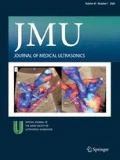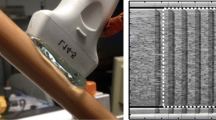Abstract
Purpose
For long time, blood clot retraction was measured only by thromboelastographic or platelet contractile force measurement techniques. The purpose of the present study was development of a novel ultrasonic method based on simultaneous monitoring of variations in the ultrasound velocity and the frequency spectrum of the signal propagating in clotting blood and its application for automatic evaluation of blood clotting parameters.
Methods
Simultaneous measurement of ultrasound velocity and variations in the frequency spectrum of wideband ultrasonic signals in clotting blood samples was performed. All measurements were performed in pulse-echo mode. Standard clinical data were obtained using routine clinical laboratory methods.
Results
The amplitudes of ultrasonic signals during native blood coagulation varied up to ten times for different frequencies. The measurement results of the start and duration of blood clot retraction differed between patient samples: different components of the blood coagulation system had significant impact on the blood clot retraction process.
Conclusions
Our results showed that during blood clotting, the ultrasound velocity and variations in frequency spectrum should be used simultaneously to determine the beginning and duration of blood clot retraction. Our results also showed that blood clot retraction is controlled by the activity of factor XIII.









Similar content being viewed by others
References
Townsend N, Nichols M, Scarborough P, et al. Cardiovascular disease in Europe—epidemiological update 2015. Eur Heart J. 2015;36:2696–705.
Weisel JW, Litvinov RI. Mechanisms of fibrin polymerization and clinical implications. Blood. 2013;121:1712–9.
Steg PG, James SK, Atar D, et al. ESC Guidelines for the management of acute myocardial infarction in patients presenting with ST-segment elevation. Eur Heart J. 2012;33:2569–619.
Schmidt H, Schmidt R, Niederkorn K, et al. Beta-fibrinogen gene polymorphism (C148– > T) is associated with carotid atherosclerosis: results of the Austrian Stroke Prevention Study. Arterioscler Thromb Vasc Biol. 1998;18:487–92.
Chen X, Xu M, Jin L, Chen J, Chen W. Association of beta-fibrinogen gene -148C/T and -455G/A polymorphisms and coronary artery disease in Chinese population: a meta analysis. Sci China C Life Sci. 2008;51:814–20.
Theodoraki EV, Nikopensius T, Suhorutsenko J, et al. Fibrinogen beta variants confer protection against coronary artery disease in a Greek case-control study. BMC Med Genet. 2010;11:28.
Kreutz RP, Bitar A, Owens J, et al. Factor XIII Val34Leu polymorphism and recurrent myocardial infarction in patients with coronary artery disease. J Thromb Thrombolysis. 2014;38:380–7.
Kucharska-Newton AM, Monda KL, Campbell S, et al. Association of the platelet GPIIb/IIIa polymorphism with atherosclerotic plaque morphology: the Atherosclerosis Risk in Communities (ARIC) Study. Atherosclerosis. 2011;216:151–6.
Hsieh L, Nugent D. Factor XIII deficiency. Haemophilia. 2008;14:1190–200.
Liang XM, Han SJ, Reems JA, et al. Platelet retraction force measurements using flexible post force sensors. Lab Chip. 2010;10:991–8.
Smyth SS, Whiteheart S, Italiano JE, Coller BS (2010) Chapter 114. In: Platelet morphology, biochemistry, and function. Prchal JT, Kaushansky K, Lichtman MA, Kipps TJ, Seligsohn U (eds) Williams hematology, 8th edn. New York: McGraw-Hill 22.
Huang CC, Lin YH, Liu TY, et al. Review: study of the blood coagulation by ultrasound. J Med Biol Eng. 2011;31:79–86.
Huang CC, Wang SH, Tsui PH. Detection of blood coagulation and clot formation using quantitative ultrasonic parameters. Ultrasound Med Biol. 2005;31:1567–73.
Shung KK, Fei DY, Yuan YW, et al. Ultrasonic characterization of blood during coagulation. J Clin Ultrasound. 1984;12:147–53.
Machado JC, von Kruger MA, Fontes EM, et al. Evaluation of an ultrasonic method applied to the measurement of blood coagulation time. Physiol Meas. 1997;18:129–43.
Libgot-Callé R, Ossant F, Gruel Y, et al. High frequency ultrasound device to investigate the acoustic properties of whole blood during coagulation. Ultrasound Med Biol. 2008;34:252–64.
Callé R, Plag C, Patat F, et al. Interest of the attenuation coefficient in multiparametric high frequency ultrasound investigation of whole blood coagulation process. J Acoust Soc Am. 2009;125:530–8.
Callé R, Rochefort GY, Desbuards N, et al. Evaluation of the sensitivity of an in vitro high frequency ultrasound device to monitor the coagulation process: study of the effects of heparin treatment in a murine model. Ultrasound Med Biol. 2010;36:295–305.
Cloutier G, Qin Z. Ultrasound backscattering from non-aggregating and aggregating erythrocytes—a review. Biorheology. 1997;34:443–70.
Shih CC, Liu TY, Huang CC. In vitro assessments of viscoelastic properties of fibrin clot by using acoustic radiation force on a solid sphere. In: Ultrasonics symposium (IUS), 2010 IEEE. IEEE, 2010. pp 479–482.
Grybauskas P, Kundrotas K, Sukackas V, et al. Ultrasonic digital interferometer for investigation of blood clotting. Ultrasonics. 1978;16:33–6.
Voleisis A, Kazys R, Mazeika L, et al. Ultrasonic method for the whole blood coagulation analysis. Ultrasonics. 2002;40:101–7.
Del Grosso VA, Mader CW. Speed of sound in pure water. J Acoust Soc Am. 1972;52:1442–6.
Tatarunas V, Jankauskiene L, Kupstyte N, et al. The role of clinical parameters and of CYP2C19 G681 and CYP4F2 G1347A polymorphisms on platelet reactivity during dual antiplatelet therapy. Blood Coagul Fibrinolysis. 2014;25:369–74.
Undas A, Brzezinska-Kolarz B, Brummel-Ziedins K, et al. Factor XIII Val34Leu polymorphism and gamma-chain cross-linking at the site of microvascular injury in healthy and coumadin-treated subjects. J Thromb Haemost. 2005;3:2015–21.
Floyd CN, Ellis BH, Ferro A. The PlA1/A2 polymorphism of glycoprotein IIIa as a risk factor for stroke: a systematic review and meta-analysis. PLoS ONE. 2014;9:e100239.
Michelson AD, Furman MI, Goldschmidt-Clermont P, et al. Platelet GP IIIa Pl(A) polymorphisms display different sensitivities to agonists. Circulation. 2000;101:1013–8.
Balogh I, Szôke G, Kárpáti L, et al. Val34Leu polymorphism of plasma factor XIII: biochemistry and epidemiology in familial thrombophilia. Blood. 2000;96:2479–86.
van Loon JE, de Maat MP, Deckers JW, et al. Prognostic markers in young patients with premature coronary heart disease. Atherosclerosis. 2012;224:213–7.
Wypasek E, Stepien E, Kot M, et al. Fibrinogen beta-chain -C148T polymorphism is associated with increased fibrinogen, C-reactive protein, and interleukin-6 in patients undergoing coronary artery bypass grafting. Inflammation. 2012;35:429–35.
Acknowledgements
These studies were funded by grants UKOAG and UKOAGII from joint funds of Lithuanian University of Health Sciences and Kaunas University of Technology.
Author information
Authors and Affiliations
Corresponding author
Ethics declarations
Ethical statement
All the procedures used have been reviewed in compliance with ethical standards of the Regional Bioethics Committee of Kaunas, Lithuania on May 12, 2014 (the permission number is BE-2-25), and the World Medical Association Declaration of Helsinki on Ethical Principles for Medical Research Involving Human Subjects. Informed consent was obtained from all patients for being included in the study.
Conflict of interest
The authors declare that they have no competing interests.
About this article
Cite this article
Tatarunas, V., Voleisis, A., Sliteris, R. et al. A novel ultrasonic method for evaluation of blood clotting parameters. J Med Ultrasonics 45, 545–553 (2018). https://doi.org/10.1007/s10396-018-0874-1
Received:
Accepted:
Published:
Issue Date:
DOI: https://doi.org/10.1007/s10396-018-0874-1




